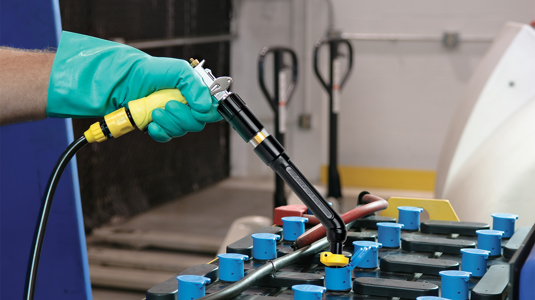How to water a lead acid battery

MONTGOMMERYVILLE, PA, February 11th, 2021: Lead acid batteries are one of the most reliable forms of energy storage on the planet. They’re easy to maintain, just charge them correctly, discharge them correctly and water them correctly and they will keep performing to their maximum potential. One of the most important factors to consider when it comes to lead acid battery maintenance is the water level. Keeping the battery hydrated means that you will have to water your battery regularly. Putting too much water in the cells reduces capacity and conversely not watering them often enough does internal damage both of which are undesirable. To make sure your lead acid battery keeps running smoothly at-all-times, we’ve put together these simple battery watering guidelines.
HOW TO WATER A LEAD ACID BATTERY?
Safety should always be first, so make sure you wear personal protection equipment such as protective eyewear, gloves and an apron when working on batteries. The two most common lead acid batteries are flooded, which require regular watering intervals and VRLA which deliver nearly maintenance-free operation. Make sure you check the information on the battery if you’re unsure which battery you have. The warning labels on your battery should direct you to, “KEEP VENT CAPS TIGHT FOLLOWING WATERING SERVICE” (flooded) or “DO NOT OPEN” the battery (VRLA). It is vitally important that you follow the warning label instructions. If you have a flooded lead acid battery then a battery watering system or battery watering gun will allow you to quickly and safely water your battery.
WHEN TO WATER A LEAD ACID BATTERY?
Flooded lead acid batteries contain a liquid called electrolyte which is a mixture of sulfuric acid and water. The plates in a lead acid battery contain an active material that should be continuously bathed in electrolytes while oxygen and hydrogen gas are released during charging. A battery should only ever be filled after it has been completely charged.
Before charging, check to make sure there is just enough water to cover any exposed plates. After charging, add enough water to bring the level to the bottom of the vent, about ¾ below the top of the cell. If you are using a battery watering system, this will automatically fill to the correct level. You can automate the checking process by using an electrolyte monitor which will give you a visual indication of when a battery needs to be filled.
It is important to note that you should never add sulfuric acid to a lead acid battery. It is both dangerous and extremely harmful to the internal workings of the battery. During normal operation batteries will only consume water, not sulfuric acid. When your battery’s water level is low, filling the battery with deionised water will keep the battery performing at its maximum.
DON’T OVER WATER
While a battery is charging, the electrolyte solution will increase in density. If water was added before charging, the electrolyte levels will expand and cause the battery to overflow. These overflows will cause the battery to lose capacity, potentially cause injury and usually result in expensive clean-up operations. Adding too much water to a lead acid battery will result in the dilution of the electrolyte where each overflow results in a reduction of 3-5% of the battery’s capacity resulting in reduced performance. Using an electrolyte monitor will prevent all of this from happening by showing you exactly when a battery needs water. If you’re not using a battery watering system, sometimes accidents can happen and if they do there are battery tray monitors, electrolyte removal pumps and spill kits are available. The tray monitor will indicate if there is any electrolyte at the bottom of the battery tray, the electrolyte removal pump makes it easy to bring the electrolyte level down within the cells of the battery so more overflows don’t happen and spill kits help absorb the electrolyte that has spilt over onto the floor.
FREQUENCY
How often do you need to add water to a lead acid battery will depend on how often it’s used. A marine or golf cart battery that is only used on the weekends may only require watering once a month. A forklift that is used every day, may need to have its battery watered once a week. The ambient temperature also affects how often a battery will need filling, as when it’s warmer the battery will need watering more often. It’s important to check a battery’s fluid level regularly and an electrolyte monitor will make these checks very easy to carry out.
AVOID TAP WATER
When filling a lead acid battery, tap water should not be used. Tap water contains minerals and micro particulates that are harmful to batteries, more so in water softened by water softeners that contain chlorides. Filling your batteries using distilled water is a much smarter investment. There are water deioniser systems available that allow you to create your own distilled water on site, usually at about 20% of what bottled distilled water costs.
So that’s it really. Check your batteries regularly, don’t let them get dehydrated, water them when they need watering especially during hot months and you will have a battery that will perform to its maximum day in day out.

